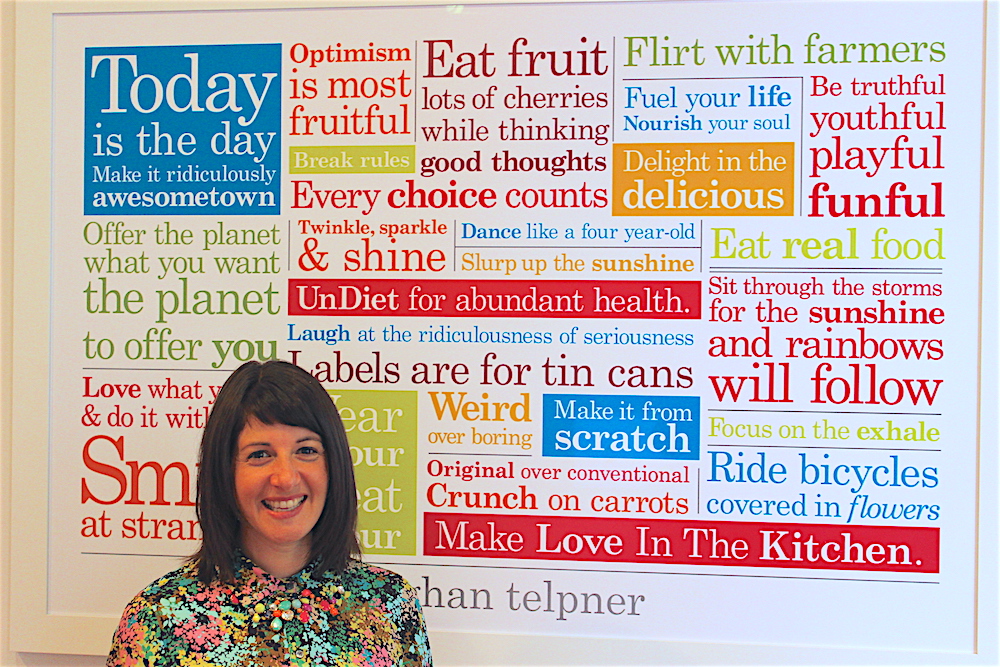
Of all the days of the year, the Tuesday after Thanksgiving is either the worst or best to visit Meghan Telpner. Long time GFR readers will remember, from Jamie’s June 2013 interview with the nutritionist, turned educator, internet broadcaster and author, that Telpner’s life mission is to help people feel exactly the opposite of what it feels like the day after a lot turkey, trimmings and wine. Oh well, if you’re going to be inspired to climb, you may as well start at the bottom.
At her West End Toronto studio, Telpner looks as vibrant and healthful as always. She is more or less her best advertising: she really glows and there is a veritable sparkle in her eye. As she tells it, that energy was absent nine years ago when she was diagnosed with Crohn’s disease. Rather than resign herself to a lifelong regime of drugs, Telpner decided to study nutrition and alter her diet radically. She claims it worked, and that story is recounted in her bestselling first book, The Undiet (2012). Telpner’s way of living and eating also informs the recipes in this new one, The Undiet Cookbook: 130 Gluten-Free Recipes For A Healthy and Awesome Life.
This interview has been edited for clarity and style.
Good Food Revolution: So, are you pleased with your second book, The Undiet Cookbook?
Meghan Telpher: I am! I am really happy with this one.
GFR: I know it’s gluten-free, but you call yourself a Meghanatarian?
MT: Yeah! There’s no one diet for everyone.
GFR: OK, but The Undiet Cookbook is ‘no wheat, no meat’?
MT: No! There is meat.
GFR: OK. You’re right, I do recall seeing an option for chicken bones for broth in one of the recipes.
MT: There’s the chicken bones. There’s also one mention of bacon, so whoever finds it wins a prize. [Laughs.] It’s gluten free and dairy free, and it’s what I call plant based. The majority of the book uses plants in their whole and unprocessed form: kale and apples and those sort of things. And, for almost every recipe there’s a grain-free, protein-powered option. So, the UnShepherd’s Pie recipe is photographed with the bean option, but there’s also a ground beef version. So, it’s up to everybody to figure out what they want.

GFR: You book strikes me as unique, but also really on trend. I’m thinking of this focus on vegetables, and chefs like Ottolenghi…
MT: Who’s that? Just kidding! [Laughs.]
GFR: Seriously, there does seem to be a real focus on what to do with your vegetables vegetables going on right now. That’s where a lot of the creative force in the food world seems to be.
MT: Well, it’s interesting. I think about the work of Dan Barber, and what he writes in The Third Plate about how the evolution of the modern diet is to make the plants the mainstay of the meal.
GFR: Right: the carrot becomes the main course.
MT: Yeah. So, I think what’s happening is that as we focus more on eating more locally and in a more sustainable way, however you want to interpret that, is part of this trend toward eating more vegetables and celebrating beautiful heirloom varieties that are available at farmers market, that are grown by someone you know and that are the most delicious. And they’re good for you! So, why not eat more of that?
GFR: OK, but I get a lot of pitches for people and books that promote some kind of health claim that’s tied to some kind of restrictive diet, that seems pretty tenuous at best. I’ve been getting a lot ‘paleo’ books lately.
MT: I feel like what works with all of them – 100% vegan, 100% paleo, or the blood type diet, there’s so many – is that it’s eliminating processed food. It’s forcing you to give time and attention to your kitchen.
I think what’s broken about all of them, and why they all work and they all don’t work, is that they’re so restrictive no one will do it forever, so they slowly end up reverting to old habits.
GFR: They just say screw it!
MT: Yeah, or I just want that piece of bread. I am personally 100% gluten-free, and I am very strict about it. At the same time, I think if I wanted it, I would eat it. I just don’t want it because I intellectually know what it will do to me and it’s not going to be good.
And all these diets work; the paleo diet works because it stabilizes blood sugar. You’re getting rid of all these carbohydrates and getting in the protein. But then, people will take it and say bacon ice-cream is a good option because it’s “paleo”. But I don’t think the paleo people were having bacon ice cream, with a side of eggs.
GFR: They also didn’t live very long.
MT: [Laughs.] They were also really active. We’re very sedentary and we need fibre or our colons aren’t going to work very well and we’re going to be full of s**t all day.
So, there’s aspects to different diets that do work, and there’s a lot of trends and a lot of claims. There are a lot of correlation studies that say things like people who drink wine every night have lower risk of heart disease. Well, is that because they have wine? Or is that because they’re in an environment where they’re actually sitting down to eat a meal every night at a table as opposed to being in a drive-through eating fast food?

GFR: Your famous back story is you came to be a nutritionist after healing yourself from illness by changing the way you ate. But you write in the Undiet Cookbook that you continue to change the way that you eat.
MT: Yeah. This has been a learning curve for me. The day I was driving to the Random House offices to sign my book deal I was in a really bad car accident. After that, I had been on a predominately vegan diet, but I just wasn’t healing. I couldn’t recover. My nervous system wasn’t recovering; my body was just not recovering. My boyfriend, now my husband, said you probably need more protein to rebuild the structures of your body. I was really reluctant. The way most people deal with vegetables, I deal with meat. I’d make a stew and put a quarter pound of meat in it, and maybe you would get a morsel. That’s how I had to introduce it into my diet, by hiding it in my vegetables. But I introduced it more and more and my recovery changed overnight. It was so much quicker. And I started feeling way better.
I have always gone with the idea that labels are for tin cans. We shouldn’t adopt a dietary trend as part of our persona – who we are. But I didn’t realize how true that really was, until I had to change what I thought was the healthiest way of eating for me, when it was no longer the healthiest way of eating for me. It opened my mind. And my guess is that if I write another cookbook in three years, it would probably, again, be very different.
As long as we can tune in, we can evolve. And I want The Undiet Cookbook to stay relevant, which is why I included those options and modifications. So we can do a recipe soy-free. We can do it nut-free. We can do it with protein. We can do it without grains, or with or without whatever you might be needing more or less of. That’s what I offer: for everyone to create their own best way of eating that promotes their own personal health.

GFR: So, what should I do? Should I just get in there and start cooking the recipes? What do I need to do to get there?
MT: I was at the Indigo head office today, and one of the questions I got was, “I don’t cook, so what’s the best recipe to start off with?” And I said, “Just open the book and the first one that appeals to you is the one you start with.”
What I think people should ask themselves is: what is the one thing I could start doing tomorrow to improve my health? Everyone has that one thing. So just do that. Take care of your list of things you know you need to do. If you do it while you eat good food, most of your stuff will take care of itself.
GFR: In your practice as a nutritionist, do you deal with a lot of broken people, like you were? Or people who are just a little out of balance?
MT: I don’t see people one-on-one anymore. What I do mostly is teach through my school, The Academy of Culinary Nutrition. I am teaching people how to share in this knowledge. Because I think that 90% of what we all need to do is just empower ourselves with the knowledge, and then do what we know we need to do.
I do get a lot of people who email or come to see us because they are experiencing serious health challenges, which is amazing because when I was in that situation nine years ago, there was no one to go to. The cookbooks were spiral bounds with titles like Gluten-Free For Life, and would be about how to make a tuna sandwich, except you’re putting it on iceberg lettuce instead of bread. That’s what was available, so I am happy to offer those resources to people who really need them.
Inflammatory bowel disease, auto-immune diseases, celiac and inflammatory diseases are not as rare as they used to be. Theses conditions are becoming more and more prevalent because of the toxic load in our environment and in our food supply, especially with the introduction of genetically modified foods. So, I get those people. But I’m also trying to get the people who aren’t there yet. Maybe they’re like, “I’m waking up in the morning and I’m a little achy,” or “I’m not sleeping very well at night.” Or, “I’m having trouble concentrating,” or “I’m so tired at two o’clock in the afternoon.” We think these things are normal, but they aren’t. Those are the people I am trying to inspire before they hit a crisis point. I want them to wake up and say, “OK, I feel good, but I could feel amazing and that’s what I want to do, and that’s the place I want to live from.”
I did media interviews on Friday, and one of the questions that every reporter asked was, “Who is this book for?”
GFR: Yes, that’s the question I was leading up to.
MT: It’s for everyone who eats. It’s for anyone who eats. I worked really hard to make sure the recipes were made from things you can get from the supermarket, and not from elite health food store, Or farmer’s market only. It’s just food, prepared in a way that is simple and delicious and easy, that feels good when you eat it. And we happen to get rid of a lot of crap in the process!
GFR: Well, I’d say you seem to be full of energy and positive things.
MT: That’s the thing. Everyone is capable of feeling good and achieving amazing health. The cooking and the food is a small part of what I do, but it’s an important part. If we get that right, then we can really explode into the world. We all have this amazing potential to do such incredible things, but most of us are too tired by the end of the day to actually execute on all the things we dream about in the morning. But what if everyone could d what they loved and were passionate about what they did every day? We would shift the entire planet in a different direction. I think a big part of that is in our food: the actual fuel that is making the cells that go into our body, and our brain, and our nervous system, and our thoughts. It matters.
Find out more about Meghan Telpner, including her Academy of Culinary online videos at meghatelpner.com.
 Malcolm Jolley is a founding editor of Good Food Revolution and Executive Director of Good Food Media, the company that publishes it. Follow him on Twitter or Facebook.
Malcolm Jolley is a founding editor of Good Food Revolution and Executive Director of Good Food Media, the company that publishes it. Follow him on Twitter or Facebook.

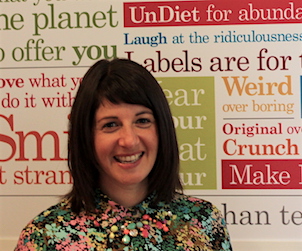
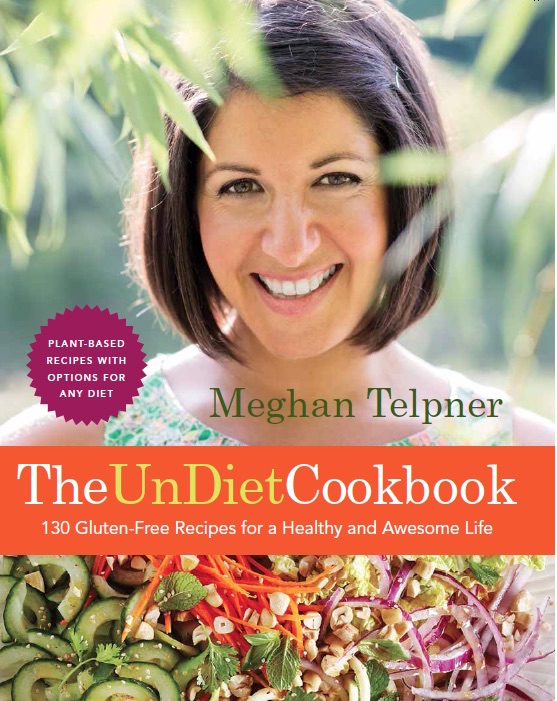

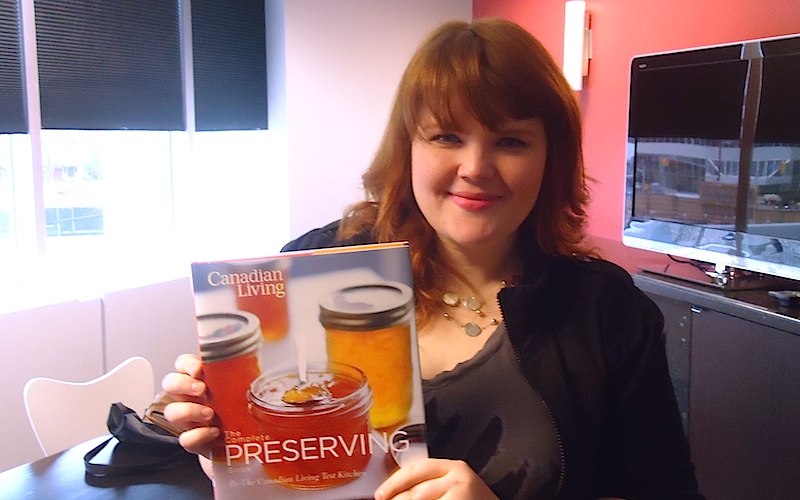
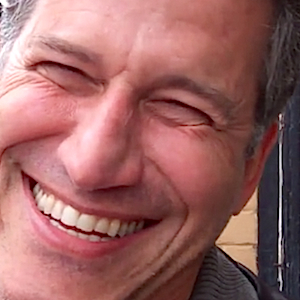
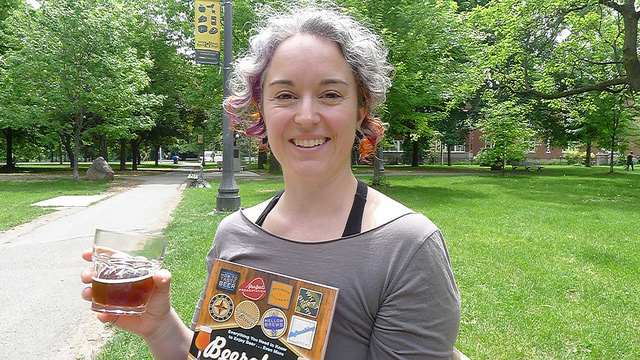
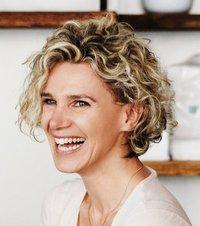

I prepared the food for Meghan’s tv appearances and
Not only was she a delight, all the recipes worked. I am a bread and pasta lover ok cookies too. But this book would still have a place on my shelf as Meghan has created many delicious recipes ranging from soups to shakes, dips desserts and mains. My personal favourite her crackers.
My university kids was home while I was doing the work for Meghan. She begged me to take the book back to school. not yet I said. I still have more I would
Like to cook.